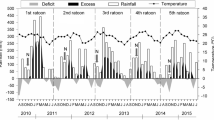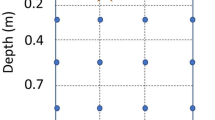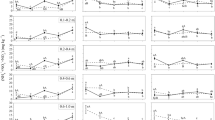Abstract
Nitrogen use efficiency is a key factor for the economic and environmental sustainability of farms. It comprises the ability for crops to recover applied fertilizer N in their aboveground biomass, called fertilizer N uptake efficiency (NupE). Sweet pearl millet [Pennisetum glaucum (L.) R.BR.] and sweet sorghum [Sorghum bicolor (L.) Moench] are C4 annual crops known for their capacity to produce high yield under N-limiting conditions, suggesting high NupE. A field study was conducted for 2 years on sandy loam soils in eastern Canada. The NupE was determined using a 15N-tracing approach. Comparisons were made for both species in regards to their response to (1) increasing mineral N rate (0–160 kg N ha−1), (2) mineral versus organic N (liquid swine and dairy cattle manures), and (3) single versus split N application. For mineral N treatments, NupE ranged from 54 to 82 %, which is greater than values generally reported for conventional crops such as corn. Moreover, NupE increased with N rates. These findings suggest than both species expressed N luxury consumption. The NupE was lower with organic than with mineral N, and a larger proportion of N remained in the soil, suggesting that N immobilization occurred. The presumed losses (unrecovered 15N) were <24 kg N ha−1 in all mineral and most organic N treatments. Splitting N application had little effect on NupE. Our results confirm that sweet pearl millet and sweet sorghum are highly efficient at recovering fertilizer N and, with adequate residue management, may represent a low environmental risk.

Similar content being viewed by others
References
Abassi MK, Tahir MM, Rahim N (2013) Effect of N fertilizer source and timing on yield and N use efficiency of rainfed maize (Zea mays L.) in Kashmir–Pakistan. Geoderma 195–196:87–93
Bagayoko M, Buerkert A, Lung G, Bationo A, Römheld V (2000) Cereal/legume rotation effects on cereal growth in Sudano-Sahelian West Africa: soil mineral nitrogen, mycorrhizae and nematodes. Plant Soil 218:103–116
Barbanti L, Grandi S, Vecchi A, Venturi G (2006) Sweet and fibre sorghum (Sorghum bicolor (L.) Moench), energy species in the frame of environmental protection from excessive nitrogen loads. Eur J Agron 25:30–39
Brown DM, Bootsma A (1993) Crop heat units for corn and other warm season species in Ontario. Factsheet, Agdex 111/31. Ontario Ministry of Agric., Food, and Rural Affairs, Queen’s Park
Carter JE, Jokela WE, Bosworth SC (2010) Grass forage response to broadcast or surface-banded liquid dairy manure and nitrogen fertilizer. Agron J 102:1123–1131
Centre de référence en agriculture et agroalimentaire du Québec, CRAAQ (2010) Guide de référence en fertilisation, 2nd edn. CRAAQ, QC, Canada
Ceotto E, Castelli F, Moschella A, Diozzi M, Di Candilo M (2014) It is not worthwhile to fertilize sweet sorghum (Sorghum bicolor L. Moench) with cattle slurry: productivity and nitrogen-use efficiency. Ind Crop Prod 62:380–386
Chantigny MH, Angers DA, Rochette P, Bélanger G, Massé D, Côté D (2007) Gaseous nitrogen emissions and forage nitrogen uptake on soils fertilized with raw and treated swine manure. J Environ Qual 36:1864–1872
Chantigny MH, Angers DA, Rochette P, Pomar C, Pelster DE (2014) Evidencing overwinter loss of residual organic and clay-fixed nitrogen from spring-applied, 15N-labelled pig slurry. Can J Soil Sci 94:1–8
Cosentino SL, Mantineo M, Testa G (2012) Water and nitrogen balance of sweet sorghum (Sorghum bicolor moench (L.)) cv. Keller under semi-arid conditions. Ind. Crop. Prod. 36:329–342
De Mazancourt C, Schwartz MW (2012) Starve a competitor: evolution of luxury consumption as a competitive strategy. Theor Ecol 5:37–49
Dordas CA, Lithourgidis AS, Matsi T, Barbayiannis N (2008) Application of liquid cattle manure and inorganic fertilizers affect dry matter, nitrogen accumulation, and partitioning in maize. Nutr Cycl Agroecosyst 80:283–296
Dos Passos Bernardes A, Tremblay GF, Bélanger G, Brégard A, Seguin P, Vanasse A (2015) Sugar yield of sweet pearl millet and sweet sorghum as influenced by harvest dates and delays between biomass chopping and pressing. Bioenerg Res 8:100–108. doi:10.1007/s12155-014-9504-y
Ecological Stratification Working Group, ESWG (1995) A National Ecological Framework for Canada. Agriculture and Agri-Food Canada, Research Branch, Centre for Land and Biological Resources Research and Environment Canada, State of the Environment Directorate, Ecozone Analysis Branch, Ottawa/Hull. http://sis.agr.gc.ca/cansis/publications/manuals/1996/A42-65-1996-national-ecological-framework.pdf. Accessed 3 November 2014
Fillery IRP, Recous S (2001) Use of enriched 15N sources to study soil N transformations. In: Unkovich M et al (eds) Stable isotope techniques in the study of biological processes and functioning of ecosystems. Kluwer Academic Publishers, Boston, pp 167–194
Financière agricole du Québec, FADQ (2015) Statistiques. Assurance-récolte. Rendements réels pour les années 1995 à 2012. www.fadq.qc.ca/statistiques_et_taux/statistiques/assurance_recolte/rendements_reels.html. Accessed 9 February 2015
Gagnon B, Ziadi N (2010) Grain corn and soil nitrogen responses to sidedress nitrogen sources and applications. Agron J 102:1014–1022
Geng S, Hills FJ, Johnson SS, Sah RN (1989) Potential yields and on-farm ethanol production cost of corn, sweet sorghum, fodderbeet, and sugarbeet. J Agron Crop Sci 162:21–29
Han LP, Steinberger Y, Zhao YL, Xie GH (2011) Accumulation and partitioning of nitrogen, phosphorus and potassium in different varieties of sweet sorghum. Field Crop Res 120:230–240
Isfan D, Zizka J, D’Avignon A, Deschênes M (1995) Relationships between nitrogen rate, plant nitrogen concentration, yield and residual soil nitrate-nitrogen in silage corn. Commun Soil Sci Plant Anal 26:2531–2557
Kirchmann H, Lundvall A (1993) Relationship between N immobilization and volatile fatty acids in soil after application of pig slurry and cattle slurry. Biol Fertil Soils 15:161–164
Leblanc V, Vanasse A, Bélanger G, Seguin P (2012) Sweet pearl millet yields and nutritive value as influenced by fertilization and harvest dates. Agron J 104:542–549
Lemaire G, Charrier X, Hébert Y (1996) Nitrogen uptake capacities of maize and sorghum crops in different nitrogen and water supply conditions. Agronomie 16:231–246
Liang BC, MacKenzie AF (1994) Corn yield, nitrogen uptake and nitrogen use efficiency as influenced by nitrogen fertilization. Can J Soil Sci 74:235–240
Liang BC, MacKenzie AF, Zhang TQ (1996) Grain yields and grain nitrogen concentration of corn as influenced by fertilizer nitrogen rate. J Agron Crop Sci 177:217–223
Morvan T, Leterme P, Arsène GG, Mary B (1997) Nitrogen transformations after the spreading of pig slurry on bare soil and ryegrass using 15 N-labelled ammonium. Eur J Agron 7:181–188
Muñoz GR, Kelling KA, Powell JM, Speth PE (2004) Comparison of estimates of first-year dairy manure nitrogen availability or recovery using nitrogen-15 and other techniques. J Environ Qual 33:719–727
Nyiraneza J, Chantigny MH, N’Dayegamiye A, Laverdière MR (2010) Long-term manure application and forages reduce nitrogen requirements of silage corn-cereal cropping systems. Agron J 102:1244–1251
Okamoto M, Okada K (2004) Differential responses of growth and nitrogen uptake to organic nitrogen in four gramineous crops. J Exp Bot 55:1577–1585
Propheter JL, Staggenborg S (2010) Performance of annual and perennial biofuel crops: nutrient removal during the first two years. Agron J 102:798–805
Ra K, Shiotsu F, Abe J, Morita S (2012) Biomass yield and nitrogen use efficiency of cellulosic energy crops for ethanol production. Biomass Bioenerg 37:330–334
Reddy GB, Reddy KR (1993) Fate of nitrogen-15 enriched ammonium nitrate applied to corn. Soil Sci Soc Am J 57:111–115
Rochette P, Chantigny MH, Angers DA, Bertrand N, Côté D (2001) Ammonia volatilization and soil nitrogen dynamics following fall application of pig slurry on canola crop residues. Can J Soil Sci 81:515–523
SAS Institute (2003) User’s guide V.9.1.3. SAS Inst., Cary
Shapiro SS, Wilk MB (1965) An analysis of variance test for normality (complete samples). Biometrika 52:591–611
Sieling K, Ni K, Kage H (2014) Application of pig slurry—first year and residual effects on yield and N balance. Eur J Agron 59:13–21
Stevens WB, Hoeft RG, Mulvaney RL (2005) Fate of nitrogen-15 in a long-term nitrogen rate study: II. Nitrogen uptake efficiency. Agron J 97:1046–1053
Subbarao GV, Nakahara K, Ishikawa T, Ono H, Yoshida M, Yoshihashi T, Zhu Y, Zakir HAKM, Deshpande SP, Hash CT, Sahrawat KL (2013) Biological nitrification inhibition (BNI) activity in sorghum and its characterization. Plant Soil 366:243–259
Thivierge M-N, Chantigny MH, Bélanger G, Seguin P, Bertrand A, Vanasse A (2015) Response to nitrogen of sweet pearl millet and sweet sorghum grown for ethanol in eastern Canada. Bioenerg Res. doi:10.1007/s12155-014-9558-x
Tran TS, Giroux M, Cescas MP (1997) Effect of N rate and application methods on 15 N-labelled fertilizer use by corn. Can J Soil Sci 77:9–19
Tripler CE, Canham CD, Inouye RS, Schnurr JL (2002) Soil nitrogen availability, plant luxury consumption, and herbivory by white-tailed deer. Oecologia 133:517–524
Wang Y, Mi G, Chen F, Zhang J, Zhang F (2005) Response of root morphology to nitrate supply and its contribution to nitrogen accumulation in maize. J Plant Nutr 27:2189–2202
Yu J, Zhang T, Zhong J, Zhang X, Tan T (2012) Biorefinery of sweet sorghum stem. Biotechnol Adv 20:811–816
Zakir HAKM, Subbarao GV, Pearse SJ, Gopalakrishnan S, Ito O, Ishikawa T, Kawano N, Nakahara K, Yoshihashi T, Ono H, Yoshida M (2008) Detection, isolation and characterization of a root-exuded compound, methyl 3-(4-hydroxyphenyl) propionate, responsible for biological nitrification inhibition by sorghum (Sorghum bicolor). New Phytol 180:442–451
Acknowledgments
The senior author gratefully acknowledges the support of the Natural Sciences and Engineering Research Council of Canada (NSERC) for a fellowship. The work was financially supported by the Programme de soutien à l’innovation en agroalimentaire (PSIA) of the Ministère de l’agriculture des pêches et de l’alimentation du Québec (MAPAQ). We thank Annie Brégard for statistical advice, and Valérie Bélanger, Marie-Eve Bernard, Amélie Desilets Roy, Johanne Tremblay, and Gabriel Lévesque for assistance during field and laboratory work.
Author information
Authors and Affiliations
Corresponding author
Rights and permissions
About this article
Cite this article
Thivierge, MN., Chantigny, M.H., Seguin, P. et al. Sweet pearl millet and sweet sorghum have high nitrogen uptake efficiency under cool and wet climate. Nutr Cycl Agroecosyst 102, 195–208 (2015). https://doi.org/10.1007/s10705-015-9689-2
Received:
Accepted:
Published:
Issue Date:
DOI: https://doi.org/10.1007/s10705-015-9689-2




